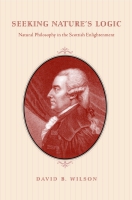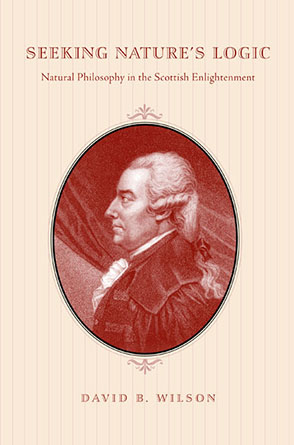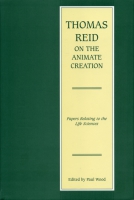Seeking Nature's Logic
Natural Philosophy in the Scottish Enlightenment
David B. Wilson
“David Wilson’s comprehensive study of Scottish Enlightenment natural philosophy explores in detail the extent to which chemical ideas shaped the teaching of natural philosophy in Scotland, the ways in which natural theological concerns drove natural philosophizing, and the ways in which metaphysical and epistemological concerns were incorporated into the teaching of natural philosophy. The scholarship is sound and reflects a thorough command of relevant printed and manuscript materials.”
- Description
- Reviews
- Bio
- Table of Contents
- Sample Chapters
- Subjects
As professor of natural philosophy at Edinburgh University from 1774 to 1805, John Robison taught the premier science of the day at the premier science university of the time. He discovered experimentally that electrical and magnetic forces were, like gravity, inverse square forces, and he wrote influential treatises on electricity, magnetism, mechanics, and astronomy. By articulating a particularly Scottish approach to physics, he was the main conceptual link between Newton and those Scottish geniuses of Victorian physics, Lord Kelvin and James Clerk Maxwell. Seeking Nature’s Logic explains the background of Robison’s natural philosophy, analyzes his own sharply shifting ideas, and places those ideas in the context of early nineteenth-century Scottish thought.
“David Wilson’s comprehensive study of Scottish Enlightenment natural philosophy explores in detail the extent to which chemical ideas shaped the teaching of natural philosophy in Scotland, the ways in which natural theological concerns drove natural philosophizing, and the ways in which metaphysical and epistemological concerns were incorporated into the teaching of natural philosophy. The scholarship is sound and reflects a thorough command of relevant printed and manuscript materials.”
“Seeking Nature’s Logic is a substantial contribution to the history of eighteenth-century science, technology, and philosophy. It is the first serious work to (rightfully) give the thought of Glasgow’s John Anderson proper attention and to explain the content and relevance of the influential natural philosophy course taught by Edinburgh’s John Robison. Drawing from a wide variety of innovative primary sources, the scholarship is extremely sound, and it will undoubtedly become a classic reference work for those interested in the history of science as it was practiced during the Scottish Enlightenment.”
“Seeking Nature’s Logic: Natural Philosophy in the Scottish Enlightenment will be required reading for those who study natural philosophy and the Scottish Enlightenment, but hopefully it will attract a wide readership, for it has things to offer many others whose scholarly interests intercept Wilson’s at one place or another.”
David B. Wilson is Professor of History and Philosophy at Iowa State University. Among his publications are Did the Devil Make Darwin Do It? Modern Perspectives on the Creation-Evolution Controversy (1983) and Kelvin and Stokes: A Comparative Study in Victorian Physics (1987).
Contents
List of Illustrations
Preface
Introduction: Descartes, Newton, and Leibniz
1. Changing Newton: The Legacy of Early Scottish Newtonians, 1690–1740
2. Midcentury Glasgow University, 1740–1760
3. The Natural Philosophy of Common-Sense Philosophy: Thomas Reid and His Colleagues, 1760–1788
4. The Natural Philosophy of Chemistry: Joseph Black and His Disciples, 1760–1786
5. Contemplating Knowledge and Nature: John Anderson, 1760–1796
6. John Robison’s Phlogiston Physics, Circa 1780
7. John Robison’s Boscovichian Physics, Circa 1800
8. Turn-of-the-Century Edinburgh University, 1790–1810
Bibliography
Index
Preface
The Scottish Enlightenment was a momentous moment in the history of Western civilization. As one modern admirer of Scotland cogently put it, “No small nation—except ancient Greece—has ever achieved an intellectual and cultural breakthrough of this magnitude.” Isaac Newton’s natural philosophy pervaded Enlightenment thinking. Placing natural philosophy within a broad conceptual context, this book takes that science from Galileo to the early nineteenth century, concentrating on Scotland during the 120 years from 1690 to 1810. Taken together, the publication of Newton’s Principia in 1687 and the death of John Robison in 1805 define that period. Newton’s work changed the course of natural philosophy, and Robison was the most significant natural philosopher of the Scottish Enlightenment.
As professor of natural philosophy at Edinburgh University from 1774 to 1805, Robison taught the premier science of the day at the premier science university of the time. He discovered experimentally that electric and magnetic forces were, like gravity, inverse square forces, and he wrote influential treatises on electricity, magnetism, mechanics, optics, and astronomy. By articulating a particularly Scottish approach to physics, he was the main conceptual link between Newton and those Scottish geniuses of Victorian physics, Lord Kelvin and James Clerk Maxwell. Kelvin was instrumental in creating the science of thermodynamics, which combined with Maxwell’s electromagnetic theory to form the context of the early twentieth-century revolution in physics. This is not at all to suggest that Robison anticipated Einstein, of course, but it does properly reaffirm the significance of the Scottish Enlightenment in the history of human thought.
This book’s chapters successively explain the background to Robison’s natural philosophy, analyze his own sharply shifting ideas, and place those ideas in the context of early nineteenth-century Scottish thought. The Introduction introduces the worldviews of René Descartes, Newton, and Gottfried Wilhelm Leibniz, providing a background summary of fundamental ideas engaged in by the Scots during the eighteenth century. Upon reading Adam Smith’s account of the history of astronomy well over a decade ago, I concluded that Descartes must have been crucial to the very acceptance of Copernicanism—much more so than generally recognized. The Introduction presents that conclusion. At the very least, that emphasis underscores Cartesianism’s centrality to natural philosophy at the time. The Introduction concludes with the early eighteenth-century quarrels between Leibniz and Newton, who responded so differently to Descartes’ ideas. The Introduction thus defines the immediate context for Chapter 1, which deals with the four principal Scottish expositors of Newtonian natural philosophy early in the eighteenth century: David Gregory, John Keill, Colin Maclaurin, and David Hume. Each presented his own distinct version of Newton’s ideas, as usually happens when disciples develop a seminal thinker’s insights. At midcentury, Glasgow University was the center of Scottish natural philosophy, and Chapter 2 probes the thinking of a Glasgow network of seven men, including Adam Smith and the chemist William Cullen. Chapter 2 concludes with John Anderson’s course in natural philosophy at Glasgow in 1760—an amalgam of ideas from chemistry, philosophy, and theology, as well as from natural philosophy. Chapters 3 and 4 present two distinctly Scottish contributions to the history of natural philosophy—the common-sense philosophy of Thomas Reid and the phlogiston chemistry of Joseph Black. Reid and Black both championed Newton but in different ways. Reid provided a widely—though not universally—accepted answer to Hume’s skepticism. Black is justly renowned for his “discovery” of latent heat, which was integral to his chemistry lectures and, unexpectedly, closely linked to Newtonian gravitational theory. A key and heretofore unanswered question concerns the respective influences of Reid’s philosophy and of Black’s chemistry on Scottish natural philosophy during the century’s final four decades.
Chapter 5 begins answering that question. John Anderson was the longest-serving professor of natural philosophy at a Scottish university during the eighteenth century. Chapter 5 extends the discussion begun in Chapter 2, following Anderson’s professorship into the 1790s. Black influenced Anderson’s course more than Reid did, although Anderson continued placing his natural philosophy within a philosophical-theological context. Both Reid and Black heavily influenced Robison’s natural philosophy course, as Chapter 6 makes clear in its discussion of Robison’s early professorship. By 1800, Robison’s earlier phlogiston physics had yielded to a Boscovichian physics, as Chapter 7 explains. He then accepted both the atomic theory of Roger Joseph Boscovich and the antiphlogiston chemistry of Antoine Lavoisier, the first happily, the second grudgingly. Chapter 7 examines those contrasting responses in its investigation of the surprising intricacies of Robison’s turn-of-the-century, end-of-life natural philosophy. The last chapter discusses three of Robison’s professorial colleagues in Edinburgh circa 1800. Attaching the names of Leibniz, Reid, and (the geologist) James Hutton, respectively, to those of John Playfair, Dugald Stewart, and John Leslie, Chapter 8 explores significant disagreements among these Edinburgh professors. Despite those differences, however, they and Robison defined the overall Scottish concept of natural philosophy that persisted well into the nineteenth century.
“Natural philosophy” could have different connotations, as seen in the contrast between Newton’s focused The Mathematical Principles of Natural Philosophy and John Anderson’s broad course in natural philosophy that even included natural history. This book concentrates on the theoretical understanding of physical nature, taking into account philosophical and theological themes as relevant—as they usually were. In that vein, the title’s “logic” entails, as most herein saw it, the structure of nature as it reflected God’s own logic of creation.
Necessity and pleasure have merged in several trips to Scotland, making archival research possible. As part of Iowa State University’s exchange program with Glasgow University, I spent a semester with Chris Black and his colleagues in Glasgow’s Department of Modern History. David Weston in Glasgow University Library’s Special Collections was exceedingly helpful then, as he had been before and has been since. I would also mention Alexander Broadie, Richard Stalley, John McCaffrey, Johanna Geyer-Kordesch, and Fiona Macdonald. Professor John M. A. Lenihan, professor of clinical physics at Glasgow, warmly supported research by others in the history of science and medicine. Professor Lenihan’s presence continues in Nancy, Christine, and Rod.
J. Malcolm Allan at Strathclyde University led me through the substantial John Anderson collection in the Andersonian. More recently, Carol Stewart has done so. I was honored to be part of Strathclyde University’s celebration of its bicentennial, when I gave a talk that has now grown into Chapter 5 and part of Chapter 2. I thank Tom Devine and Gordon Donaldson.
The Royal Philosophical Society of Glasgow aided my research with two travel grants and kindly made me an honorary member. My thanks to Leslie W. Barr, George Gorman, David A. R. Forrester, and Nancy Campbell.
For parts of two years, I was a Visiting Research Fellow at Edinburgh University’s Institute for Advanced Studies in the Humanities, directed by Peter Jones and guided by Anthea Taylor. A grant from the National Science Foundation (SBR-9601998) greatly helped. I presented an early version of Chapter 6 at IASH, followed by insightful comments from Andrew Skinner and Michael Barfoot. Among the many who assisted me one way or another in Edinburgh, I would especially mention Jean Jones, John Henry, Alan Barnard, Erica Thomas, and Walter and Mary Lutz. John V. Howard, Arnott Wilson, and their colleagues in Edinburgh University Library’s Special Collections were enormously helpful in my several visits, some extended some rather brief. The National Library of Scotland and the Edinburgh City Archives also eased my archival research there.
Also crucial were librarians at the other libraries listed in the bibliography. Norman Reid at St. Andrews University assisted me with their significant collection of John Robison’s manuscripts and books. The Special Collections Department of the William Robert Parks and Ellen Sorge Parks Library at Iowa State University has important holdings relevant to eighteenth-century Scotland, and Tanya Zanish-Belcher and her staff are always thoughtful and efficient.
The Dibner Institute for the History of Science and Technology twice accepted me as a Senior Fellow. That regrettably vanished gem for the profession was then under the respective directorships of Jed Buchwald and George Smith. Evelyn Simha, Bonnie Edwards, Trudy Kontoff, Rita Dempsey, Carla Chrisfield, and Dawn Davis Loring made the institute function. I presented versions of Chapters 6 and 7 in my two tenures—receiving comments and questions from many, including Dimitri Constant, Deborah Cramer, Noah Efron, Jean Eisenstaedt, Sungook Hong, Jeremiah James, Ursula Klein, Ben Marsden, Carl Posy, Joan Richards, Jessica Riskin, Roger Smith, Glen Van Brummelen, and Steve Weininger.
I presented versions of Chapter 1 in Edinburgh and Cambridge. First was the Edinburgh meeting of the Eighteenth-Century Scottish Studies Society. Wisely shepherded by Richard Sher, ECSSS successfully encourages scholarship on the Scottish Enlightenment. M. A. Stewart’s suggestion followed that talk. I next presented Chapter 1 at Cambridge University’s Department of the History and Philosophy of Science, and in Cambridge I am indebted to Jennifer Downes, Richard Noakes, Liba Taub, Simon Schaffer, Jim Secord, Patricia Fara, and Jayne Ringrose.
Presentations in other places have also improved the book. I presented a paper on John Anderson at the meeting of the Midwest Junto for the History of Science held in honor of Duane H. D. Roller. I was asked to talk in Edinburgh about doing research in John Robison’s manuscripts at a “dissemination event” of Navigational Aids for the History of Science, Technology, and the Environment. Material from different chapters has been included in other presentations. One was at a Conference on Science and Medicine in the Enlightenment, held in Edinburgh and sponsored by IASH. We had a lively discussion about Thomas Reid. A second was at a Seven Pines Conference, and my thanks go to Alan Shapiro. Third was my contribution to a Workshop, “Between Leibniz, Newton, and Kant,” at the Max Planck Institute for the History of Science, Berlin. That presentation was published as “Enlightenment Scotland’s Philosophico-Chemical Physics,” in Wolfgang Lefèvre, ed., Between Leibniz, Newton, and Kant: Philosophy and Science in the Eighteenth Century (Dordrecht: Kluwer Academic, 2001), 129–45. In a much-expanded form, portions of that publication have become Chapters 2 through 6 of this volume. That material is reproduced here by kind permission of Springer Science and Business Media. I have greatly appreciated Wolfgang Lefèvre’s support for this project.
I have learned from those masters of science in the Scottish Enlightenment, Paul Wood and Roger Emerson. Eric Dean at Wabash College and Maurice Mandelbaum at Johns Hopkins University taught me the history of philosophy, and Thomas K. Gaisser recommended the subject to me in the first place. I have had interesting discussions over the years with my colleagues in Iowa State’s Philosophy Department, especially Robert Hollinger, Michael Bishop, Joseph Kupfer, William Robinson, and Tony Smith. Robert Kargon is an excellent example for those wanting to do research in more than one century. So is Peter Harman.
Others who have contributed to this volume include Daniela Barbaris, Julian Bourg, Irene Danks, Matthew Eddy, Margaret Osler, Blair Williams, and my fellow historians at Iowa State. A publication subvention grant from the Iowa State University Publication Endowment Fund has greatly assisted publication. Iowa State has also provided leaves for research and funds for travel. Two anonymous reviewers for the Pennsylvania State University Press offered sage advice. In mentioning specific people to whom I am indebted, I have undoubtedly omitted some who should have been included, and I regret that.
Ideally, teaching and research blend, and that happily has been the case here. Students in one of my courses at Iowa State regularly retry Galileo, for example, and those in another were the first to read the Cartesian part of the Introduction. Originating in a graduate seminar that I offered on Scotland were two articles in this book’s bibliography—one by Amy Ackerberg-Hastings on John Playfair, the other by Robinson Yost on John Robison.
Finally, ever present have been family: John, Lynda, Jim, Joan, Wing, Jamie, Eric, and especially Natasha, Bryan, Allyson, and Emily. But most of all there is Julie, who has been closely involved in all stages of research and writing on this project. She has literally had the last word!
D.B.W.
Ames
April 2008
Also of Interest
Mailing List
Subscribe to our mailing list and be notified about new titles, journals and catalogs.





